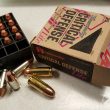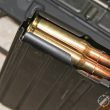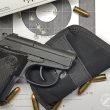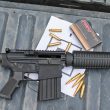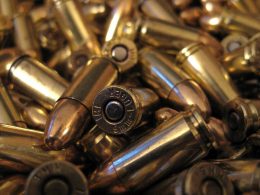It’s not uncommon to mistake a vapor trail for a bullet trace and vice-a-versa as these shooting terminologies are often used interchangeably. However, chances are that you’re mostly seeing a bullet trace because a vapor trail is quite rare and needs unique conditions to be visible.
Bullet trace, vapor trail, frost trail, shock wave, these are colloquial terms for a trace, a general reference to disturbing the air density when firing a gun. The trace is the visible movement of air caused by a bullet in flight and lets you actually follow the path it takes.
The air density is affected with the rapid flight of anything passing through and with the right air conditions, the effects of this air disturbance are noticeable. But, scientifically, a bullet trace, vapor trail, or whichever terms you’re using are not one in the same and occur under different conditions and for different reasons.
So, let’s distinguish between the vapor trail and the bullet trace, which are two very different ballistic phenomena.
Bullet Trace
You can see a bullet trace in nearly any climatic condition with a good scope. By observing the first trace, it’s then possible to adjust more accurately for subsequent rounds. To follow the trace, stand behind the shooter and look down the middle of the target. On firing, the air pressure is disturbed causing natural light refraction. Light is a significant factor in observing a bullet trace because what you’re actually seeing are different refractions of light bending through pressure.
With good lighting behind the shooter, the bullet trace is very apparent as the light aligns. The same would work if the light is behind the target. Because a bullet trace is a result of displaced air and hence refracted light, with the right mix of environmental elements and looking straight downrange, you’ll be able to catch a glimpse of it clearly.
The background color and texture of the target influences the visibility of the trace. So, the darker the background, the more noticeable the bullet trace. It doesn’t imply a trace is invisible against lighter backgrounds, but it’s just a bit harder to catch unless you have a trained eye. Textures with random patterns would interfere with its prominence so solid, consistent patterns would be more suitable. And, try to avoid movement in the background because the more distractions will make the bullet trace harder to detect.
You can try setting up a camera directly behind you to record the bullet trace and use slow motion speeds for entertainment viewing and analysis. Sometimes it can be tricky to pick up the bullet trace but after good practice, you’ll train your eye to catch the airborne projectile.
If you want to see a bullet trace for the first time as an observer, stand behind the shooter with your eye on the line of bore (looking straight down the center of the gun), from the shooter’s line of sight through to the target. Make sure you are in a safe position without distracting the shooter. Use binoculars to be slightly off focus while facing the target. Find a spot on which to concentrate so when the gun fires, a shimmer will momentarily appear like camouflaged movement. This is the bullet trace.
BONUS OFFER: Get your free shooting range targets to print at home!
Get your free targets to print at home!
Vapor Trail
And, then there’s the vapor trail. This is a rare phenomenon and very different to the bullet trace.
People may go through years of shooting and not see a vapor trail or only see one or two. The recipe required to witness this ballistic event is dependent on the weather conditions and the firearm being used. Favorable circumstances related to temperature, humidity, and background color all affect the visibility of the vapor trail.
Upon firing, the bullet is released which causes a change in air pressure and a visible white trail appears. The concept is similar to that of fighter jets breaking the sound barrier, a large white cloud appears in a split second because of the sudden change in air pressure. As mentioned above with the bullet trace, you have to be behind the shooter looking downrange to see it, but with a vapor trail, you simply need to have a view of the weapon discharging the projectile. Basically, a low-pressure system is created by the air behind the bullet. The low pressure pulls moisture in from the surrounding air, creating the fleeting appearance of a white cloud.
Input from experienced shooters was summarized for those who are curious about setting the scene that’s conducive to an observable vapor trail.
First off, you need humidity as the condensation particles will cause the bullet to leave a white trail in the air (like the fighter jet example). And, if you have the right light, it is highly likely you’ll be able to see the actual difference in pressure at the back of the bullet as it flies through the air. So, an ideal setting would be with high humidity, a dark background color, low wind (not exceeding 10 mph), and early morning sunlight or late afternoon sun. The reason no to low wind is required is because it can dissipate the vapor trail and if the sun is directly overhead, the glare from the light obscures the trail’s visibility.
Earlier on, another trace was mentioned, the frost trail. Knowing what a vapor trail is, the same event occurs but in rare circumstances where an extremely cold temperature freezes the vapor trail (hence a frost trail), making it visible for a few seconds longer.
In Summary
If you can plan it well to coincide with atmospheric luck and apply the fundamentals of shooting skills, it’s possible for anyone to learn how to see a trace. It’s a subtle observation of movement exposing its flight path under the right conditions.
Gaining a better understanding of the effects and observation techniques significantly enables the shooter’s ability to rectify adjustments and elevation after a first-round miss. Training the eye will help develop better accuracy, a higher hit rate and overall improved shooting performance. In all cases, having a good scope always helps.

